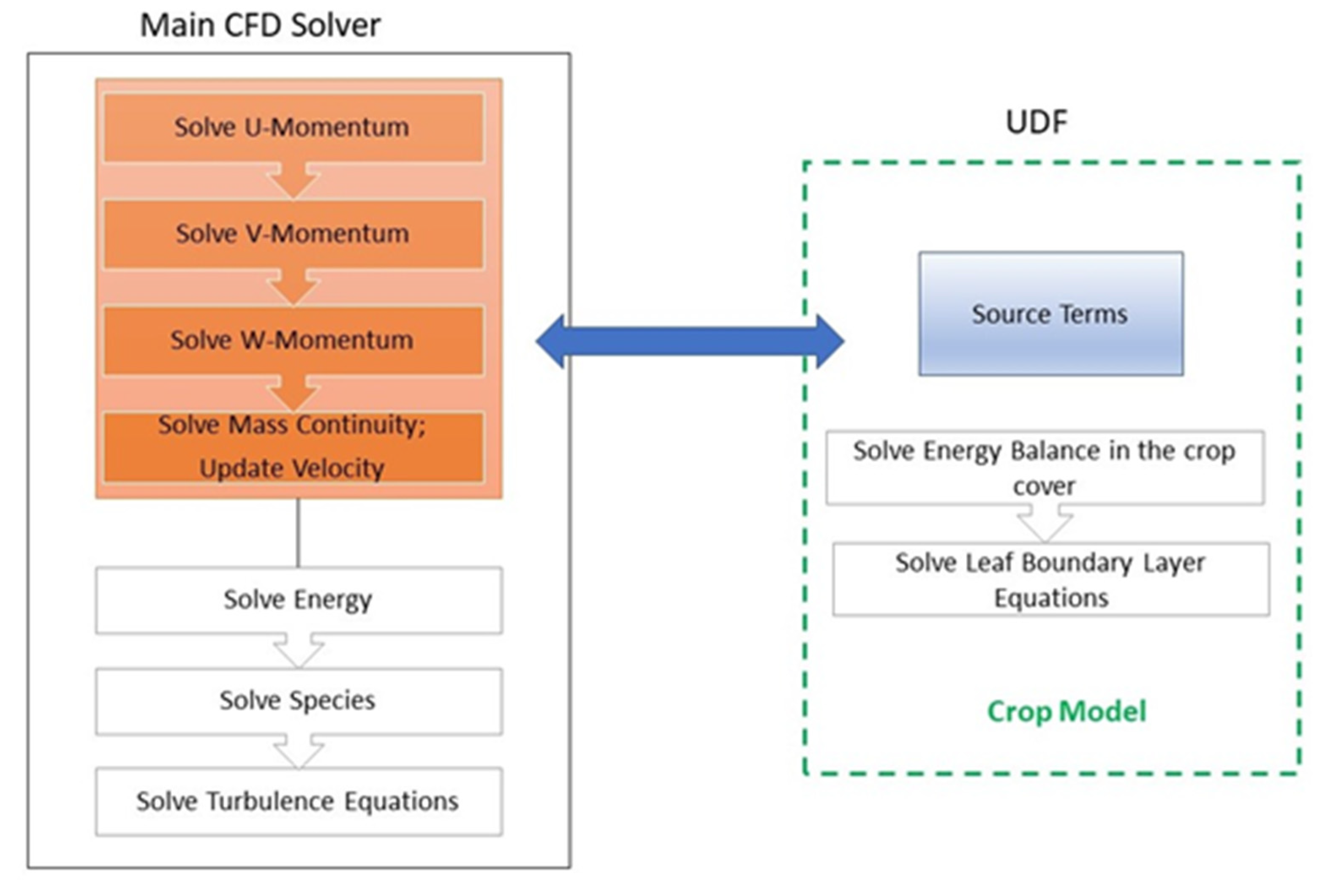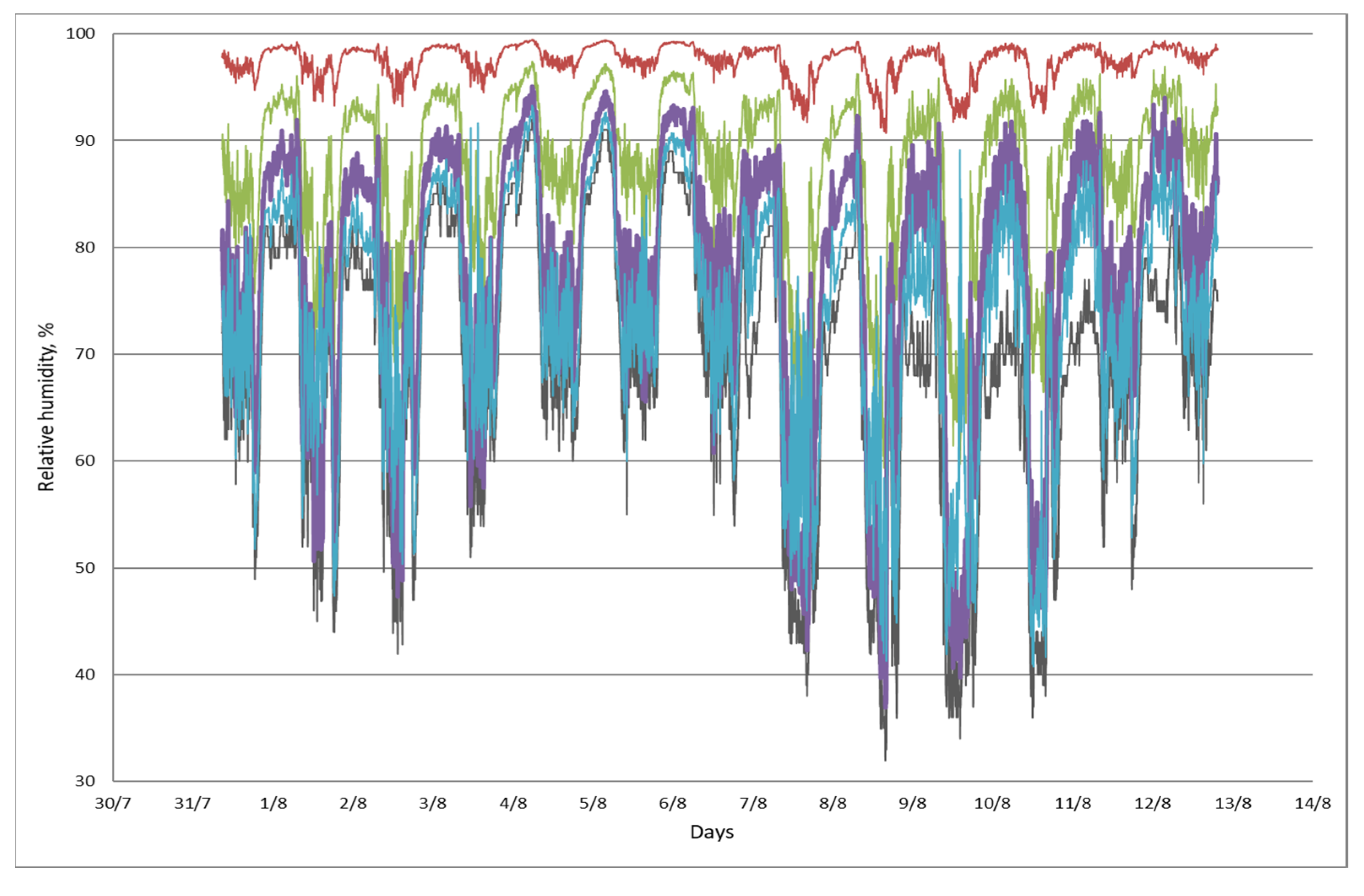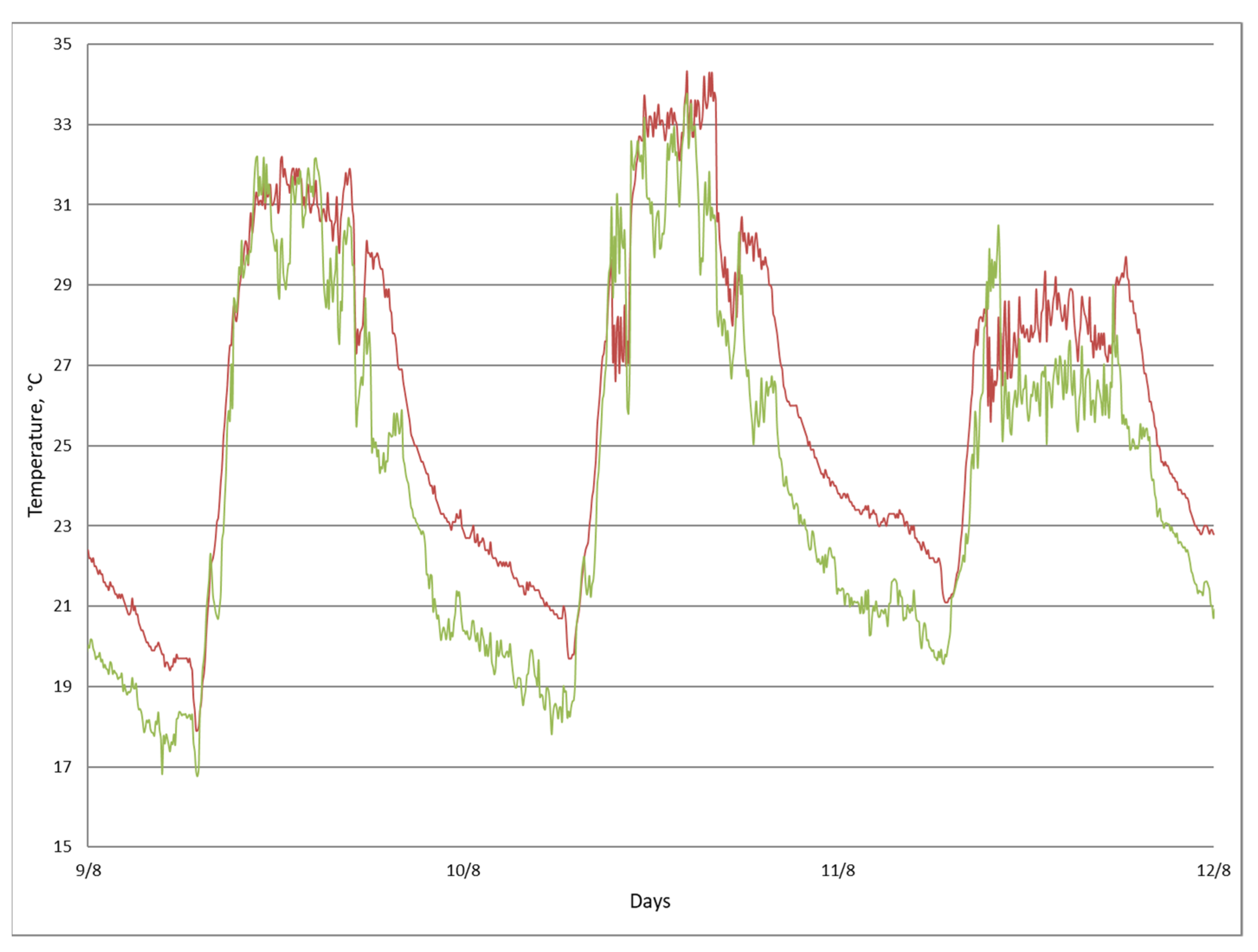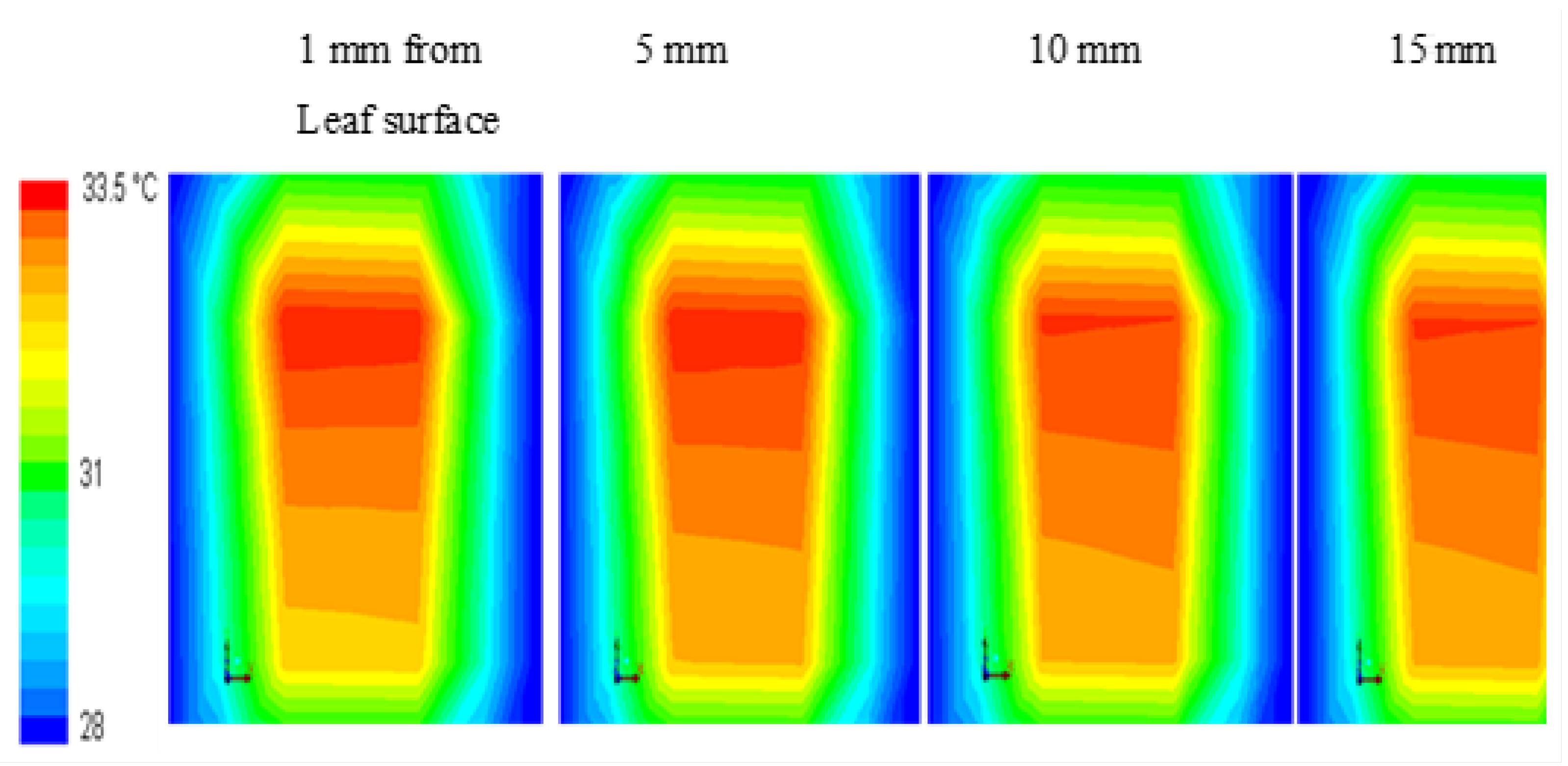Computational Fluid Dynamics Modelling of the Microclimate within the Boundary Layer of Leaves Leading to Improved Pest Control Management and Low-Input Greenhouse
Abstract
:1. Introduction
2. Materials and Methods
2.1. The Greenhouse
2.2. The Numerical Model
2.3. Numerical Modelling of the Microclimate in the Leaf Boundary Layer
2.4. The Boundary Conditions
3. Results and Discussion
3.1. Leaf Boundary Layer Climate Analysis
3.1.1. Leaf Boundary Layer Thickness
3.1.2. Temperature and Humidity in the Leaf Boundary Layer
3.2. Effects of Varying the Environmental Factors in the Greenhouse on the Microclimate in the Boundary Layer
4. Conclusions
Author Contributions
Funding
Institutional Review Board Statement
Informed Consent Statement
Data Availability Statement
Conflicts of Interest
References
- Boulard, T.; Mermier, M.; Fargues, J.; Smits, N.; Rougier, M.; Roy, J.C. Tomato leaf boundary layer climate: Implication for microbiological control of whiteflies in greenhouse. Agric. For. Meteorol. 2002, 110, 159–176. [Google Scholar] [CrossRef]
- Jones, H.G. Plants and Microclimate: A Quantitative Approach to Environmental Plant Physiology, 3rd ed.; Cambridge University Press: Cambridge, UK, 2014; 407p. [Google Scholar]
- Pincebourde, S.; Woods, H.A. Climate uncertainty on leaf surfaces: Perspectives on the leaf microclimate from biophysical ecology. Funct. Ecol. 2012, 26, 844–853. [Google Scholar] [CrossRef]
- Woods, H.A.; Potter, K.A. Life in leaf boundary layers: How two millimeters of still air affects the performance and ecology of small insects. Integr. Comp. Biol. 2010, 50 (Suppl. 1), E193. [Google Scholar]
- Sheriff, D.W. An infra-red psychrometer for detecting changes in the humidity of leaf boundary layers. J. Exp. Bot. 1973, 24, 641–647. [Google Scholar] [CrossRef]
- Grace, J.; Wilson, J. Boundary-layer over a populus leaf. J. Exp. Bot. 1976, 27, 231–241. [Google Scholar] [CrossRef]
- Boulard, T.; Fatnassi, H.; Roy, J.C.; Lagier, J.; Fargues, J.; Smits, N.; Rougier, M.; Jeannequin, B. Effect of Greenhouse Ventilation on Humidity of inside air and in leaf boundary-layer. Agric. For. Meteorol. 2004, 125, 225–239. [Google Scholar] [CrossRef]
- Katsoulas, N.; Baille, A.; Kittas, C. Leaf boundary layer conductance in ventilated greenhouses. An experimental approach. Agric. For. Meteorol. 2007, 144, 180–192. [Google Scholar] [CrossRef]
- Kimura, K.; Yasutake, D.; Yamanami, A.; Kitano, M. Spatial examination of leaf-boundary-layer conductance using artificial leaves for assessment of light airflow within a plant canopy under different controlled greenhouse conditions. Agric. For. Meteorol. 2020, 280, 107773. [Google Scholar] [CrossRef]
- Nikolaou, G.; Neocleous, D.; Kitta, E.; Katsoulas, N. Estimation of aerodynamic and canopy resistances in a Mediterranean greenhouse based on instantaneous leaf temperature measurements. Agronomy 2020, 10, 1985. [Google Scholar] [CrossRef]
- Ferro, D.N.; Southwick, E.E. Microclimates of small arthropods-estimating humidity within the leaf boundary-layer. Environ. Entomol. 1984, 13, 926–929. [Google Scholar] [CrossRef]
- Roy, J.-C.; Vidal, C.; Fargues, J.; Boulard, T. CFD based determination of temperature and humidity at leaf surface. Electron. Agric. 2008, 61, 201–212. [Google Scholar] [CrossRef]
- Fatnassi, H.; Poncet, C.; Bazzano, M.M.; Brun, R.; Bertin, N. A numerical simulation of the photovoltaic greenhouse microclimate. Sol. Energy 2015, 120, 575–584. [Google Scholar] [CrossRef]
- Fatnassi, H.; Boulard, T.; Poncet, C.; Chave, M. Optimisation of greenhouse insect screening with Computational Fluid Dynamics. Biosyst. Eng. 2006, 93, 301–312. [Google Scholar] [CrossRef]
- Boulard, T.; Wang, A. Experimental and numerical study on the heterogeneity of crop transpiration in a plastic tunnel. Comput. Electron. Agric. 2002, 34, 173–190. [Google Scholar] [CrossRef]
- Fatnassi, H.; Boulard, T.; Bouirden, L. Simulation of climatic conditions in full-scale greenhouse fitted with insect-proof screens. Agric. For. Meteorol. 2003, 118, 97–111. [Google Scholar] [CrossRef]
- Kacira, M.; Sase, S. Optimization of vent configuration by evaluating greenhouse and plant canopy ventilation rates under wind induced ventilation. Trans. ASAE 2004, 47, 2059–2067. [Google Scholar] [CrossRef]
- Majdoubi, H.; Boulard, T.; Fatnassi, H.; Bouirden, L. Airflow and microclimate patterns in a one-hectare Canary type greenhouse: An experimental and CFD assisted study. Agric. For. Meteorol. 2009, 149, 1050–1062. [Google Scholar] [CrossRef]
- Nebbali, R.; Roy, J.; Boulard, T.; Nebbali, R.; Roy, J.; Boulard, T. Dynamic simulation of the distributed radiative and convective climate within a cropped greenhouse. Renew. Energy 2012, 43, 111–129. [Google Scholar] [CrossRef]
- Sase, S.; Kacira, M.; Boulard, T.; Okushima, L. Determination of porosity parameters for tomato canopy: An experimental study in a wind tunnel. Trans. ASABE 2012, 55, 1921–1927. [Google Scholar]
- Tamimi, E.; Kacira, M.; Choi, C.; An, L. Analysis of climate uniformity in a naturally ventilated greenhouse equipped with high pressure fogging system. Trans. ASABE 2013, 56, 1241–1254. [Google Scholar]
- Kichah, A.; Bournet, P.E.; Migeon, C.; Boulard, T. Measurements and CFD simulations of microclimate characteristics and transpiration of an Impatiens pot plant crop in a greenhouse. Biosyst. Eng. 2012, 112, 22–34. [Google Scholar] [CrossRef]
- Boulard, T. Recent trends in protected cultivations-microclimate studies: A review. Acta Hortic. 2012, 957, 15–28. [Google Scholar] [CrossRef]
- Schlichting, H. Boundary Layer Theory; McGraw-Hill: New York, NY, USA, 1979; 817p. [Google Scholar]
- Wang, S.; Boulard, T.; Haxaire, R. Air speed profiles in a naturally ventilated greenhouse. Agric. For. Meteorol. 1999, 96, 181–188. [Google Scholar] [CrossRef]
- Potter, K.; Davidowitz, G.; Woods, H.A. Insect eggs protected from high temperatures by limited homeothermy of plant Leaves. J. Exp. Biol. 2009, 212, 3448–3454. [Google Scholar] [CrossRef] [PubMed] [Green Version]









Publisher’s Note: MDPI stays neutral with regard to jurisdictional claims in published maps and institutional affiliations. |
© 2021 by the authors. Licensee MDPI, Basel, Switzerland. This article is an open access article distributed under the terms and conditions of the Creative Commons Attribution (CC BY) license (https://creativecommons.org/licenses/by/4.0/).
Share and Cite
Fatnassi, H.; Boulard, T.; Poncet, C.; Katsoulas, N.; Bartzanas, T.; Kacira, M.; Giday, H.; Lee, I.-B. Computational Fluid Dynamics Modelling of the Microclimate within the Boundary Layer of Leaves Leading to Improved Pest Control Management and Low-Input Greenhouse. Sustainability 2021, 13, 8310. https://doi.org/10.3390/su13158310
Fatnassi H, Boulard T, Poncet C, Katsoulas N, Bartzanas T, Kacira M, Giday H, Lee I-B. Computational Fluid Dynamics Modelling of the Microclimate within the Boundary Layer of Leaves Leading to Improved Pest Control Management and Low-Input Greenhouse. Sustainability. 2021; 13(15):8310. https://doi.org/10.3390/su13158310
Chicago/Turabian StyleFatnassi, Hicham, Thierry Boulard, Christine Poncet, Nikolaos Katsoulas, Thomas Bartzanas, Murat Kacira, Habtamu Giday, and In-Bok Lee. 2021. "Computational Fluid Dynamics Modelling of the Microclimate within the Boundary Layer of Leaves Leading to Improved Pest Control Management and Low-Input Greenhouse" Sustainability 13, no. 15: 8310. https://doi.org/10.3390/su13158310
APA StyleFatnassi, H., Boulard, T., Poncet, C., Katsoulas, N., Bartzanas, T., Kacira, M., Giday, H., & Lee, I.-B. (2021). Computational Fluid Dynamics Modelling of the Microclimate within the Boundary Layer of Leaves Leading to Improved Pest Control Management and Low-Input Greenhouse. Sustainability, 13(15), 8310. https://doi.org/10.3390/su13158310








